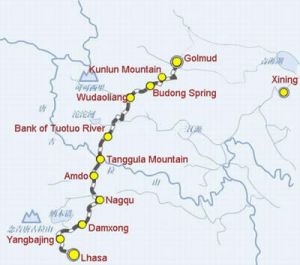Difference between revisions of "Qinghai-Tibet Railway"
imported>Graceshanshan |
imported>Graceshanshan |
(No difference)
| |
Revision as of 05:11, 18 May 2009
Qinghai-Tibet Railway
The Qinghai-Tibet Railway is a symbolic project in China's West Development Strategy and will play a significant role in accelerating the social and economic development of Qinghai Province and Tibet Autonomous Region. It’s envisaged that the rail link will help build up ethnic solidarity and benefit people of many ethnic groups. The construction of the line was a strategic decision taken by the Central Committee of the Communist Party of China (CPC) and the State Council at the outset of the 21st century.
The 1956-kilometer railway link begins in Xining, capital city of Qinghai Province and goes to Lhasa, capital city of Tibet Autonomous Region. The 814 kilometer-long stretch from Xining to Golmud was built in 1979 and started operation in 1984. The 1142 kilometer stretch between Golmud and Lhasa runs south along the Qinghai-Tibet Highway and was constructed by rebuilding the original 32-kilometer-long line from Golmud to Nanshankou and laying 1110 kilometers of new track.
The railway construction was complex and highly demanding for those involved. They confronted a range of challenges including perennial frozen ground, severe cold, a lack of oxygen because of the altitude and care had to be taken with the fragile ecology which was all round the construction work.
Work started on June 29, 2001. Up to March 25, 2006 investment in the project stood at 28.5 billion yuan (about US$3.6 billion) – 1.2 billion yuan (US$150 million) of which was spent on environmental protection projects. Trial operations will begin on July 1, 2006 with a total investment of 6.5 billion yuan (US$812 million) being made in this part of the project.
The Qinghai-Tibet Plateau has long been described as "the Roof of the World" and the third polar region. It's the starting point of many of China's rivers. In building the Qinghai-Tibet Railway, great care has been taken to protect the unique, fragile and sensitive geographical environment of this plateau.
The highest point on the line is 5,072 meters above sea level. The railway covers 960-kilometers at an altitude of more than 4000 meters and over 550 kilometers within the "frozen earth" area.
To effectively protect the ecological environment was an extremely important part of the railway's construction and is the focus of attention from both home and abroad. The Chinese authorities attached significant importance to this issue.
Former President Jiang Zemin and former Premier Zhu Rongji both required to implement the related regulations of the State Council to protect the ecological environments of Qinghai and Tibet.
